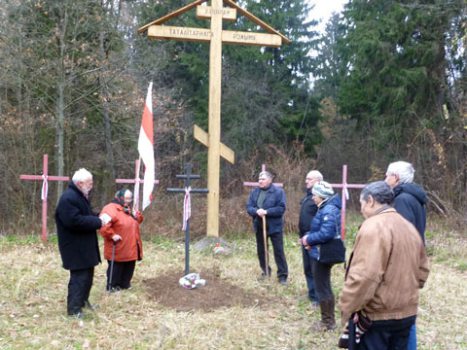Victims of Stalin's repressions commemorated in Vitsebsk region
Commemorative events were held in Vitsebsk, Polatsk and Orsha. Local activists honor the memory of those shot in the 1930-50-ies, on their own initiative: public authorities prefer not to mention those events at all.
November 1, Vitsebsk activists visited the self-made memorial near the village of Paliayi (in the photo). Here on the edge of the forest, civilians were executed by Stalin's butchers. There is an inscription “In the memory of victims of the totalitarian regime” on the largest cross. All in all, there are seven crosses which were erected at different times, starting from the 1990-ies. Several crosses have been destroyed since then, but new ones were erected.
Despite the fact that older residents still remember Stalin's shootings, this place is not officially considered a memorial. Representatives of various opposition parties have repeatedly appealed to the authorities to make a real monument there, but have always received only refusals. Therefore, improvement of the improvised memorial has become a matter of caring people. At least two times a year they clear the place from garbage. On Forefathers' Day, Dziady, they always lay flowers and light candles.
Another memorial place is located near Platsk. November 1, believers of the Greek-Catholic Church of St. Josaphat gathered for a common prayer at Belchytskiya cemetery. Thereis a Cross of suffering in the memory of Belarusians, repressed by the Soviet regime.
Kabyliatskaya hill near Orsha is the second officially recognized place of execution of civilians, the second one after Minsk Kurapaty. But here commemorative events take place exclusively on the initiative of the public. In the early 1990-ies human remains were found there during the construction of the railway. An examination found that this was a place of mass executions. 30 years ago a monument to the victims was installed there – a stone with a plaque. The latter was repeatedly stolen by unknown vandals. The authorities did not engage in the restoration: the official monument gradually turned into a makeshift memorial: a boulder, two wooden crosses, Catholic and Orthodox, and several memorial signs installed with someone's private initiative, remind about the tragic events. The victims' names are listed on the signs. Every year on Forefathers' Day the local activists clear the territory of the memorial and hold commemorative actions, attended by relatives of those shot in this place. People share their memories and bring flowers.


















